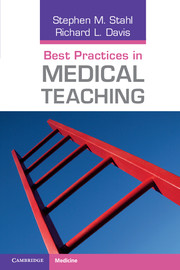Book contents
- Frontmatter
- Contents
- Preface
- About the authors
- Foreword
- Acknowledgments
- Introduction
- 1 Applying the principles of adult education to the designing of medical presentations
- 2 Using audience learning psychology to advantage in designing and delivering medical presentations
- 3 Executing the principles of adult learning in medical presentations
- 4 Measuring outcomes and ensuring success
- 5 Using interval learning in a comprehensive medical educational program
- References
- Progress check answer keys
- Progress check answer sheets
- Index
3 - Executing the principles of adult learning in medical presentations
Published online by Cambridge University Press: 05 August 2011
- Frontmatter
- Contents
- Preface
- About the authors
- Foreword
- Acknowledgments
- Introduction
- 1 Applying the principles of adult education to the designing of medical presentations
- 2 Using audience learning psychology to advantage in designing and delivering medical presentations
- 3 Executing the principles of adult learning in medical presentations
- 4 Measuring outcomes and ensuring success
- 5 Using interval learning in a comprehensive medical educational program
- References
- Progress check answer keys
- Progress check answer sheets
- Index
Summary
Chapter overview
Chapter 3 examines how instructors can maximize effectiveness by balancing their presentation efforts between “what is said” and “how it is said.” Constructing a successful educational presentation is similar to constructing any other object. The job requires a combination of factors: namely, having a plan plus having the required tools and then applying the skilled use of those tools leads to a successful “build.” This chapter explores an array of tools and how to use them to increase the success of presentations.
Personality affects both sides of the communication equation. A presenter's personality style will affect how he or she chooses to communicate with the audience. The various personalities represented in the audience will influence how the instructor's message is received. Because personality affects the way learners perceive an instructor, the instructor's ability to convey knowledge hinges in part upon personality. The key to effectiveness for an instructor is to know his or her own style and what strategies need to be employed to expand success across all personality styles. This chapter will discuss how knowing personality styles of oneself and one's audience (e.g. by using DiSC definitions) can allow an instructor to leverage his/her personality style to enhance the transmission of information.
Practice and preparation are critical keys to success. Understanding the components of preparation allows for the development of a thorough plan that can be practiced. Practicing the “what” and “how” until it all becomes second nature facilitates exceptional presentations.
- Type
- Chapter
- Information
- Best Practices in Medical Teaching , pp. 95 - 116Publisher: Cambridge University PressPrint publication year: 2011

